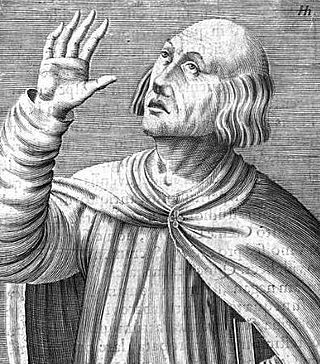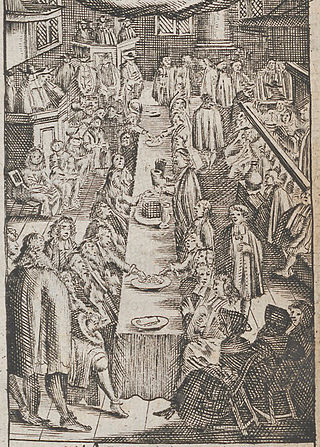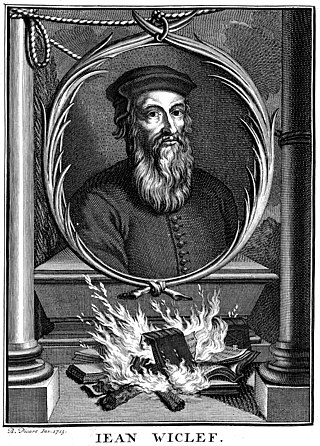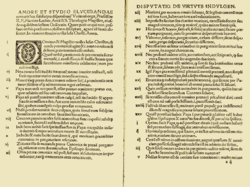
Transubstantiation is, according to the teaching of the Catholic Church, "the change of the whole substance of bread into the substance of the Body of Christ and of the whole substance of wine into the substance of the Blood of Christ". This change is brought about in the eucharistic prayer through the efficacy of the word of Christ and by the action of the Holy Spirit. However, "the outward characteristics of bread and wine, that is the 'eucharistic species', remain unaltered". In this teaching, the notions of "substance" and "transubstantiation" are not linked with any particular theory of metaphysics.

Berengar of Tours, in Latin Berengarius Turonensis, was an 11th-century French Christian theologian and archdeacon of Angers, a scholar whose leadership of the cathedral school at Chartres set an example of intellectual inquiry through the revived tools of dialectic that was soon followed at cathedral schools of Laon and Paris. Berengar of Tours was distinguished from mainline Catholic theology by two views: his assertion of the supremacy of Scripture and his denial of transubstantiation.

The real presence of Christ in the Eucharist is the Christian doctrine that Jesus Christ is present in the Eucharist, not merely symbolically or metaphorically, but in a true, real and substantial way.
Peter of Bruys was a medieval French religious teacher. He was called a heresiarch by the Roman Catholic Church because he opposed infant baptism, the erecting of churches and the veneration of crosses, the doctrine of transubstantiation and prayers for the dead. An angry Roman Catholic mob murdered him in or around 1131.

Jerome of Prague was a Czech scholastic philosopher, theologian, reformer, and professor. Jerome was one of the chief followers of Jan Hus and was burned for heresy at the Council of Constance.

In Christian theology, the term Body of Christ has two main but separate meanings: it may refer to Jesus Christ's words over the bread at the celebration of the Jewish feast of Passover that "This is my body" in Luke 22:19–20, or it may refer to all individuals who are "in Christ" 1 Corinthians 12:12–14.
Protestant Reformers were theologians whose careers, works and actions brought about the Protestant Reformation of the 16th century.

In Christianity, a Eucharistic miracle is any miracle involving the Eucharist. The Roman Catholic, Lutheran, Eastern Orthodox, Methodist, Anglican and Oriental Orthodox Churches believe that Christ is really made manifest in the Eucharist and deem this a Eucharistic miracle; however, this is to be distinguished from other manifestations of God. The Catholic Church distinguishes between divine revelation, such as the Eucharist, and private revelation, such as Eucharistic miracles. In general, reported Eucharistic miracles usually consist of unexplainable phenomena such as consecrated Hosts visibly transforming into myocardium tissue, being preserved for extremely long stretches of time, surviving being thrown into fire, bleeding, or even sustaining people for decades.
Metousiosis is a Greek term (μετουσίωσις) that means a change of ousia.

Eucharist is the name that Catholics give to the sacrament by which, according to their belief, the body and blood of Christ are present in the bread and wine that are consecrated during the Catholic eucharistic liturgy, generally known as the Mass. The definition of the Eucharist in the 1983 Code of Canon Law as the sacrament where Christ himself "is contained, offered, and received" points to the three aspects of the Eucharist according to Catholic theology: the real presence of Christ in the Eucharist, Holy Communion, and the holy sacrifice of the Mass.

"Lauda Sion" is a sequence prescribed for the Roman Catholic Mass for the feast of Corpus Christi. It was written by St. Thomas Aquinas around 1264, at the request of Pope Urban IV for the new Mass of this feast, along with Pange lingua, Sacris solemniis, and Verbum supernum prodiens, which are used in the Divine Office.
The Eucharistic Credo is a profession of faith in the Real Presence of Jesus in the sacramental Eucharistic elements written in 1078 by Pope Gregory VII.
Heresy in Christianity denotes the formal denial or doubt of a core doctrine of the Christian faith as defined by one or more of the Christian churches.

Disciplina arcani was a custom that prevailed in the 4th and 5th centuries of Christianity, whereby knowledge of certain doctrines and rites of the Christian religion was kept from non-Christians and even from those who were undergoing instruction in the faith so that they may progressively learn the teachings of the faith and not fall to heresy due to simplistic misunderstandings.

A dogma of the Catholic Church is defined as "a truth revealed by God, which the magisterium of the Church declared as binding". The Catechism of the Catholic Church states:
The Church's Magisterium asserts that it exercises the authority it holds from Christ to the fullest extent when it defines dogmas, that is, when it proposes, in a form obliging Catholics to an irrevocable adherence of faith, truths contained in divine Revelation or also when it proposes, in a definitive way, truths having a necessary connection with these.

Baptism, Eucharist and Ministry (BEM), also known as the Lima Document, is a Christian ecumenical document adopted by members of the World Council of Churches in Lima in January 1982.
Heresy is defined by the Catholic Church as "the obstinate denial or obstinate doubt after the reception of baptism of some truth which is to be believed by divine and Catholic faith". The term heresy connotes both the belief in itself, and the attitude towards said belief.

In Reformed theology, the Lord's Supper or Eucharist is a sacrament that spiritually nourishes Christians and strengthens their union with Christ. The outward or physical action of the sacrament is eating bread and drinking wine. Reformed confessions, which are official statements of the beliefs of Reformed churches, teach that Christ's body and blood are really present in the sacrament, and that believers receive, in the words of the Belgic Confession, "the proper and natural body and the proper blood of Christ." The primary difference between the Reformed doctrine and that of Catholic and Lutheran Christians is that for the Reformed, this presence is believed to be communicated in a spiritual manner rather than by his body being physically eaten. The Reformed doctrine of real presence is called "pneumatic presence".
Stercoranism is a supposed belief or doctrine attributed reciprocally to the other side by those who in the eleventh century upheld and those who denied the Christian doctrine of transubstantiation, that the bread and wine offered in the Eucharist become in substance, but not in form, the body and blood of Jesus Christ.

Proto-Protestantism, also called pre-Protestantism, refers to individuals and movements that propagated ideas similar to Protestantism before 1517, which historians usually regard as the starting year for the Reformation era. The relationship between medieval sects and Protestantism is an issue that has been debated by historians.













